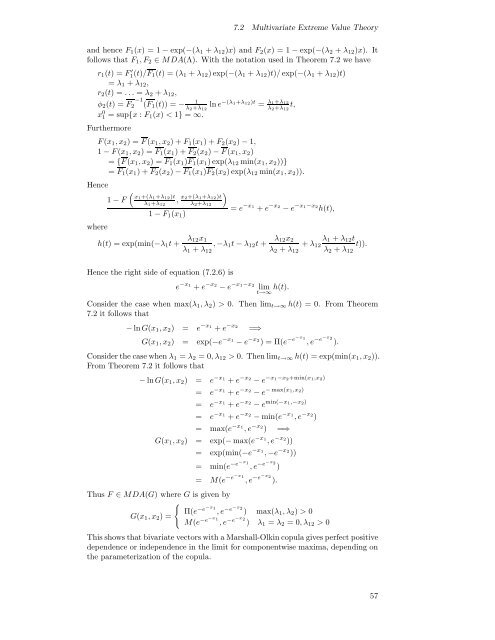Modelling Dependence with Copulas - IFOR
Modelling Dependence with Copulas - IFOR
Modelling Dependence with Copulas - IFOR
Create successful ePaper yourself
Turn your PDF publications into a flip-book with our unique Google optimized e-Paper software.
7.2 Multivariate Extreme Value Theory<br />
and hence F 1 (x) =1− exp(−(λ 1 + λ 12 )x) andF 2 (x) =1− exp(−(λ 2 + λ 12 )x). It<br />
follows that F 1 ,F 2 ∈ MDA(Λ). With the notation used in Theorem 7.2 we have<br />
r 1 (t) =F 1(t)/F ′ 1 (t) =(λ 1 + λ 12 )exp(−(λ 1 + λ 12 )t)/ exp(−(λ 1 + λ 12 )t)<br />
= λ 1 + λ 12 ,<br />
r 2 (t) =...= λ 2 + λ 12 ,<br />
−1<br />
φ 2 (t) =F 2 (F1 (t)) = − 1<br />
λ 2+λ 12<br />
ln e −(λ1+λ12)t = λ1+λ12<br />
λ 2+λ 12<br />
t,<br />
x 0 1 =sup{x : F 1 (x) < 1} = ∞.<br />
Furthermore<br />
F (x 1 ,x 2 )=F (x 1 ,x 2 )+F 1 (x 1 )+F 2 (x 2 ) − 1,<br />
1 − F (x 1 ,x 2 )=F 1 (x 1 )+F 2 (x 2 ) − F (x 1 ,x 2 )<br />
= {F (x 1 ,x 2 )=F 1 (x 1 )F 1 (x 1 )exp(λ 12 min(x 1 ,x 2 ))}<br />
= F 1 (x 1 )+F 2 (x 2 ) − F 1 (x 1 )F 2 (x 2 )exp(λ 12 min(x 1 ,x 2 )).<br />
Hence<br />
where<br />
1 − F<br />
(<br />
x1+(λ 1+λ 12)t<br />
)<br />
, x2+(λ1+λ12)t<br />
λ 2+λ 12<br />
1 − F 1 (x 1 )<br />
λ 1+λ 12<br />
= e −x1 + e −x2 − e −x1−x2 h(t),<br />
h(t) =exp(min(−λ 1 t + λ 12x 1<br />
λ 1 + λ 12<br />
, −λ 1 t − λ 12 t + λ 12x 2<br />
λ 2 + λ 12<br />
+ λ 12<br />
λ 1 + λ 12 t<br />
λ 2 + λ 12<br />
t)).<br />
Hence the right side of equation (7.2.6) is<br />
e −x1 + e −x2 − e −x1−x2 lim h(t).<br />
t→∞<br />
Consider the case when max(λ 1 ,λ 2 ) > 0. Then lim t→∞ h(t) = 0. From Theorem<br />
7.2 it follows that<br />
− ln G(x 1 ,x 2 ) = e −x1 + e −x2 =⇒<br />
G(x 1 ,x 2 ) = exp(−e −x1 − e −x2 )=Π(e −e−x 1<br />
,e −e−x 2<br />
).<br />
Consider the case when λ 1 = λ 2 =0,λ 12 > 0. Then lim t→∞ h(t) =exp(min(x 1 ,x 2 )).<br />
From Theorem 7.2 it follows that<br />
− ln G(x 1 ,x 2 ) = e −x1 + e −x2 − e −x1−x2+min(x1,x2)<br />
= e −x1 + e −x2 − e − max(x1,x2)<br />
= e −x1 + e −x2 − e min(−x1,−x2)<br />
= e −x1 + e −x2 − min(e −x1 ,e −x2 )<br />
= max(e −x1 ,e −x2 ) =⇒<br />
G(x 1 ,x 2 ) = exp(− max(e −x1 ,e −x2 ))<br />
= exp(min(−e −x1 , −e −x2 ))<br />
= min(e −e−x 1<br />
,e −e−x 2<br />
)<br />
= M(e −e−x 1<br />
,e −e−x 2<br />
).<br />
Thus F ∈ MDA(G) whereG is given by<br />
{<br />
G(x 1 ,x 2 )=<br />
Π(e −e−x 1<br />
,e −e−x 2<br />
) max(λ 1 ,λ 2 ) > 0<br />
,e −e−x 2<br />
) λ 1 = λ 2 =0,λ 12 > 0<br />
M(e −e−x 1<br />
This shows that bivariate vectors <strong>with</strong> a Marshall-Olkin copula gives perfect positive<br />
dependence or independence in the limit for componentwise maxima, depending on<br />
the parameterization of the copula.<br />
57
















